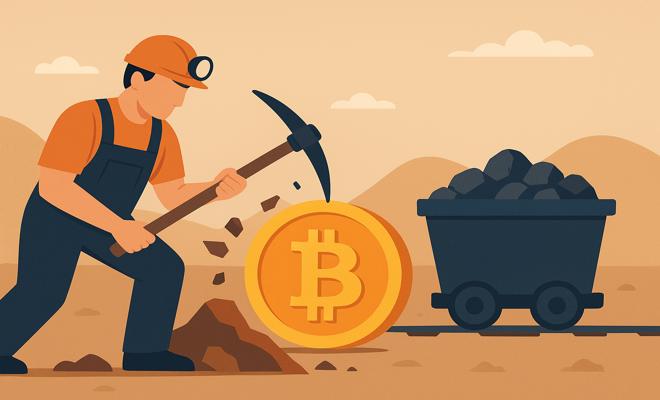
How Mining Creates New Bitcoins
Bitcoin Mining is the process that both secures the Bitcoin network and creates new bitcoins. Miners gather pending transactions, bundle them into a block, and race to solve a mathematical puzzle. The first miner to solve it earns the right to add the block to the blockchain and receives a block reward (new bitcoins) plus transaction fees.
This race isn’t about smart tricks it’s about computing power. The network sets a difficulty target, and miners try countless guesses (nonces) until one produces a valid block hash. Because this work is verifiable by anyone, it lets strangers agree on a single history of transactions without a central authority.
The Proof-of-Work puzzle in plain English
Proof-of-Work (PoW) asks miners to find a hash that’s smaller than a network-defined target. Hashes are the output of a one-way function (SHA-256) that turns the block’s contents plus a nonce into a 64-character code. Change the nonce, you change the hash so miners try billions or trillions of nonces per second.
A helpful analogy: imagine rolling a huge die over and over until you roll a number below a strict cutoff. The network moves that cutoff up or down (the difficulty) so that, on average, a valid roll appears every ~10 minutes. That automatic difficulty adjustment keeps new block creation steady over time.
Hashes, nonces, and difficulty why they matter
A hash is a fingerprint of data; two different inputs almost never produce the same output. A nonce (number used once) is the value miners change each attempt. Plug block data + nonce into SHA-256, compare the result to the target; if it’s low enough, you win the round and propose the block.
Difficulty rises or falls every 2,016 blocks to target a ~10-minute block time. When more machines join and the total hash rate climbs, the difficulty increases so blocks don’t arrive too quickly. When hash rate drops, difficulty eases so blocks don’t slow to a crawl. This balancing act keeps the network predictable.
Rewards, halvings, and programmed scarcity
When a miner finds a valid block, the protocol issues a block reward new bitcoins minted into existence plus the transaction fees inside that block. This is how Bitcoin Mining creates new coins while simultaneously validating the ledger.
Every ~4 years (210,000 blocks), a halving cuts the block reward in half. Halvings slow the issuance of new coins and are the core of Bitcoin’s programmed scarcity. Over time, rewards trend toward zero, and fees are expected to play a bigger role in paying miners for security.
What it really takes?
Today’s miners use ASICs (application-specific integrated circuits) built for SHA-256. They’re far more efficient than CPUs or GPUs, but they aren’t cheap, and they consume substantial electricity. Profitability depends on your power price, machine efficiency, upfront costs, and how often you can keep rigs online.
On the software side, beginners often start with manufacturer tools or open-source miners and connect to a mining pool. You’ll also need a wallet to receive payouts and basic monitoring so you can track temperatures, uptime, and hash rate. Reliable cooling and dust control are must-haves for hardware longevity.
Key pros and cons at a glance
- Pros: Network security is rewarded; transparent rules; permissionless entry; potential profit if your costs are low and operations are efficient.
- Cons: High upfront costs; significant electricity use; noisy, hot equipment; thinning margins as competition rises.
- Risks: Price volatility, regulatory changes, hardware obsolescence, and pool centralization (depending too much on a few big players).
- Mitigations: Choose efficient ASICs, secure low-cost power, join reputable pools, plan for maintenance, and model your break-even with conservative assumptions.
Mining pools and your odds of success
Solo mining is like buying a single lottery ticket you might win, but the odds are tiny. Mining pools combine the hash power of many miners and share rewards proportionally to contributed work. You’ll see smaller, more frequent payouts instead of waiting for a rare solo win.
Pool choice matters. Consider fee structure, payout method, reputation, geographic distribution, and how transparently the pool reports statistics. A dependable pool reduces variance, but always remember: payouts are still ultimately tied to Bitcoin’s price, network difficulty, and your own operating costs.